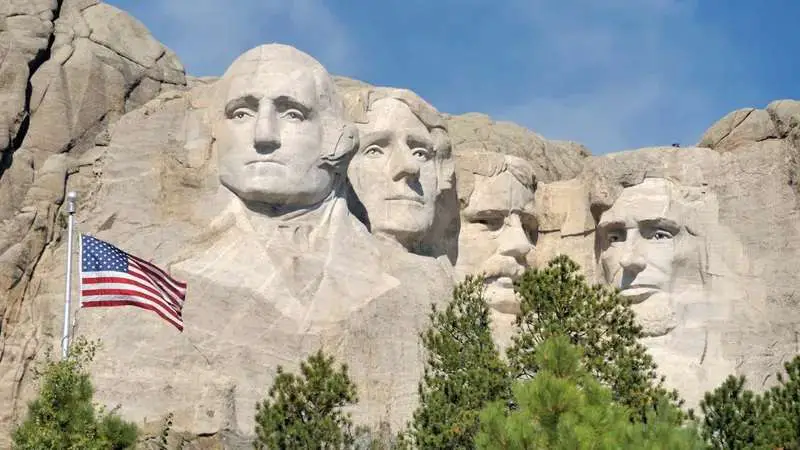Table of Contents
Mount Rushmore: The Intriguing Hidden Chamber
Within the realm of American history and conspiracy theories, there exists a tale that seems ripped from the pages of a Hollywood adventure script, reminiscent of blockbuster movies like “National Treasure.” Yet, the theory that something extraordinary lies concealed within the monumental edifice of Mount Rushmore predates its portrayal on the silver screen.
Hidden behind the sculpted likeness of Abraham Lincoln lies a secret chamber, an architectural curiosity that has intrigued generations. This enigmatic space, envisioned by the monument’s sculptor, Gutzon Borglum, features an 18-foot door leading into a cavernous chamber measuring 74 feet in length and 35 feet in height.
Its primary purpose was to safeguard some of America’s most cherished documents, including the Declaration of Independence and the Constitution. Additionally, it was designed to serve as a symbolic shrine, a testament to artistic ambition and national pride.
The Grand Vision of Gutzon Borglum
Gutzon Borglum’s vision for Mount Rushmore was nothing short of audacious. His original concept featured an 800-foot-long grand staircase, leading from the monument’s front to a lavish “Hall of Records.” The Hall was intended to be an opulent space adorned with gilded splendor and intricate historical artifacts.
However, the reality today stands in stark contrast to Borglum’s visionary dreams. Instead of housing the nation’s most precious historical treasures, the hidden chamber now serves as a memorial to the sculptor himself. This transformation was triggered by budget constraints in 1939, a mere year after the commencement of construction.
Tragically, Gutzon Borglum passed away just seven months later, leaving behind an intriguing void that has continued to captivate the curiosity of history enthusiasts and conspiracy theorists alike.
The Mysterious Legacy of Borglum
In 1998, the Borglum family gathered to pay tribute to the artist’s monumental work. Within the hidden chamber, they placed a set of 16 porcelain panels, each bearing inscriptions from the very documents that Borglum had aspired to enshrine within the space.
These panels were reverently laid to rest within an underground teakwood box, and the burial site was solemnly capped with a granite stone, etched with an eloquent quote from the sculptor himself. The commemoration was a poignant gesture that sought to honor the sculptor’s original vision, even if it had remained unfulfilled.
The Birth of Conspiracy Theories
The existence of this concealed chamber has spurred numerous conspiracy theories over the years. Skeptics have questioned whether it is merely a memorial or if it conceals a deeper secret—a clandestine vault for classified government documents, perhaps.
While compelling evidence supporting such claims remains elusive, the intrigue surrounding this visitor-restricted space persists. It serves as a testament to the enduring allure of historical mysteries and the human inclination to seek hidden truths.
The Quest for Hidden Secrets
The allure of hidden chambers and concealed knowledge has captured the human imagination throughout history. From ancient pyramids to modern government facilities, the idea of hidden spaces containing enigmatic treasures or classified information has been a recurring theme. In the case of Mount Rushmore, the legend of a hidden chamber adds an extra layer of fascination to an already iconic American monument.
Historical Context: A Nation’s Foundation
To understand the significance of preserving important documents within Mount Rushmore, we must delve into the historical context. The Declaration of Independence and the Constitution are not just pieces of paper; they are the foundational documents of the United States.
They encapsulate the ideals upon which the nation was built, laying out the principles of democracy, freedom, and self-governance. Safeguarding these documents in a symbolic shrine would have been a powerful statement, emphasizing the enduring importance of these values.
Gutzon Borglum: The Visionary Sculptor
Gutzon Borglum, the mastermind behind Mount Rushmore, was a visionary sculptor known for his colossal creations. He believed in the power of art to inspire and commemorate. Mount Rushmore was not his only ambitious project; he had previously worked on the Stone Mountain Confederate Memorial in Georgia. His desire to leave a lasting mark on the American landscape is evident in the grandeur of his sculptures.
The Budgetary Cutbacks of 1939
The transformation of the hidden chamber into a memorial to Gutzon Borglum was not a matter of choice but a consequence of budget cuts in 1939. The monument’s construction had been progressing slowly, and with the outbreak of World War II looming on the horizon, funds were redirected to more pressing wartime needs. This budgetary constraint marked a turning point in the monument’s history, forever altering its original design and purpose.
Conspiracy Theories in American History
Conspiracy theories have a long history in the United States. From the Illuminati to Area 51, Americans have shown a persistent fascination with hidden truths and government secrets. This cultural phenomenon is not limited to the U.S.; it is a global phenomenon driven by curiosity and mistrust of official narratives.
The Visitor-Restricted Space
The inaccessibility of the hidden chamber only adds to its mystique. While Mount Rushmore attracts millions of visitors each year, very few have had the opportunity to glimpse this secluded room. Its restricted status has led some to speculate about what might lie within its walls, fueling the enduring mystery.
Conclusion: A Monument Shrouded in Intrigue
In conclusion, Mount Rushmore, with its hidden chamber, stands as a monument not only to the vision of its creator, Gutzon Borglum, but also to the enduring fascination with historical mysteries and hidden secrets.
Whether the chamber was intended as a repository for America’s most cherished documents or serves as a testament to the power of conspiracy theories, it continues to captivate imaginations and remind us of the complexities of history, art, and human curiosity. While the truth behind the hidden chamber may remain elusive, its legacy endures as a symbol of the enduring quest for knowledge and understanding.
You might also read:

